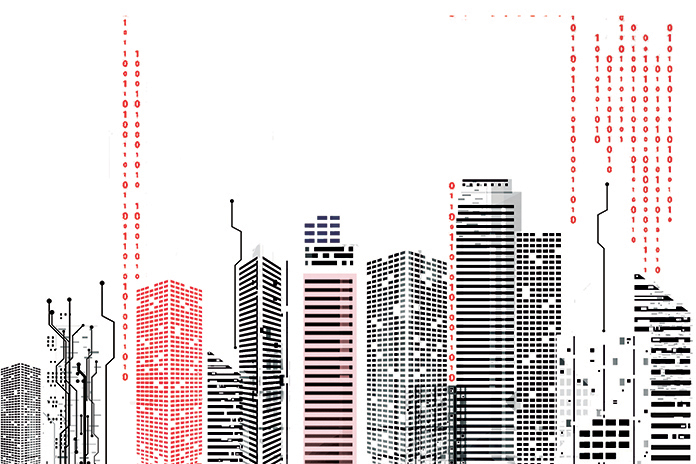
With many industry professionals forced to work remotely, is now the perfect time for construction to get up to speed with all things BIM and digital? CM finds out if the coronavirus will change the way we work forever.
David Philp – Global BIM/MIC consultancy director, Aecom
‘An opportunity to rethink how we use technology and innovate’

The coronavirus pandemic is forcing us to strive for more innovative and rapid solutions. From increased home working needs, maximising performance of our healthcare estates and ultimately how we can recover from the looming economic challenges, we need to usher in new ways of working.
This crisis will be an opportunity for us to rethink construction priorities, how we can better use technology and innovate in the use of joined-up data to support immediate societal needs and the creation of a more resilient built environment.
In these testing times we cannot afford to waste this crisis – innovation and new ways of thinking are the priority and will help both businesses and society survive and accelerate recovery.
Digital has already helped us collaborate but perhaps the pandemic will help us make better use of these tools to ‘hyper-collaborate’ virtually and share information more freely to help us cope and recover.
Social distancing will undoubtedly spark technological innovation and we will think up new ways to congregate online and better communicate via our digital channels.
Garry Fannon – Technology director, Turner & Townsend
‘Early digital adopters will be reaping the rewards’

Our technology team have all been set up to work from home for some time and the early adopters will reap the rewards from the coronavirus lockdown.
Work with clients on their visions and the next steps they need to take to get there is carrying as normal via videoconferencing. Design teams are able to continue working – creating a fully designed digital model that can be constructed to an excellent quality standard when work is able to begin on site.
This could also be an opportunity for offsite manufacturers, where projects are delayed. Projects where design has begun would need to go back to first principles and require some redesign work. Clients with projects at a less advanced stage might think modularising will accelerate the programme.
The situation will help understanding of cloud technology, and also test how well the cloud works, as we’re not used to so many people accessing it at once. There are also security questions about home working – we need to educate people and show them how to make home routers more secure.
But overall, the enforced lockdown could show the industry how we can use digital technology to be much more efficient and productive.
Mark Boyle – Global design director, Robert Bird
‘Our digital processes lend themselves to remote working’

Our staff are well used to collaborating and working with their counterparts in other countries via videoconference and screen-sharing technology – 95% of our work is office based and can be done remotely.
So it was a relatively easy transition from office to home working once we initially got the systems working and hardware distributed. Hardware was especially important for CAD technicians who benefit from larger multiple screens.
We have been bringing in more digital processes into our design approach which also lend themselves to remote working. Early indications are the current crisis is speeding up the rate of adaption of these more efficient processes.
We are having to find ways of communicating and working with clients and collaborators who have different technology to us or who are not as familiar with remote working techniques, but this is no doubt a journey all businesses are on and we are confident it will not be a significant barrier to continued working together.
Andrew Gamblen – Digital manager, Willmott Dixon
‘People will become more comfortable collaborating remotely’

The effect of Covid-19 and social distancing is going to have a long-lasting effect on both the construction sector and the UK as a whole. There has been a huge increase in the use of technology and software that allows individuals and teams to communicate and collaborate remotely.
While this technology has been around for a while, and because we are in a position where we have to use it to keep working, people are starting to become a lot more comfortable with it and this is building up simple routines that will have a lasting effect.
It won’t be long until these simple routines are augmented with further digital software and techniques that will give even greater momentum to adoption of digital construction across the industry. I don’t know what things will be like by the end of the epidemic, but I do know we definitely won’t be working in the same way as we were before.
Richard Saxon CBE Chairman of JCT, client adviser at Deploi BIM Strategies
‘“Wartime scenario” will push the digital agenda’

The Covid-19 crisis is looking very like a war scenario. Organisations are sending out messages saying they will play their part
through staff working from home. It’s Keep Calm and Carry On again.
Technology has always developed rapidly in wartime. The Second World War saw the birth of computing, radar, jet aircraft and nuclear power. Now we have a design and construction industry in lockdown, starting to rely on tools which only a few firms have used so far.
Companies with multiple offices or overseas projects have long been able to share work down the line with colleagues and associate firms. Now cloud-based teamwork applications allow staff to work from home or on the move with full access to their firm’s common data environment.
The leaders are showing the way after stress-testing remote working arrangements. The rest will follow faster than they otherwise would have, pushing tech adoption down the supply chain. The pressure to roll out superfast broadband and 5G will be immense.
The need for human connection is not being ignored either. Social media apps allow for virtual co-working, so that you can see your colleagues and they you. Online meetings are well supported now and soon we will use virtual site visit technology as normal.
Assuming we get on top of testing for the virus, site work will be aided by augmented reality headsets and BIM caves, which support better briefing and error-free execution. Offsite construction will also advance as it can provide safer working conditions.
By the time a vaccine is available, a year or more of forced advance in technology use is likely to have passed. News of what others are doing will spread through networks and webinars. Things will not go back to where they were before: productivity will have improved; flexible working will have become normal; whole-life thinking will have advanced.










